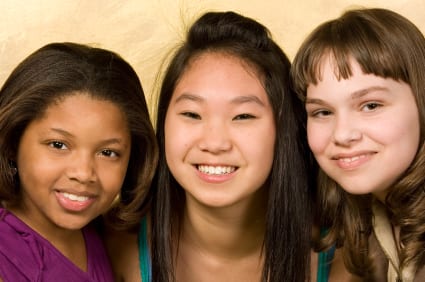With Dr. Martin Luther King, Jr. at the fore of our minds, we at Modern Mom would like to share with you the writings of author Mallika Chopra. In this excerpt from her book, 100 Questions from My Child, Mallika found a gentle way to talk to her young daughters, Tara, and Leela, about race and class, two issues central to Dr. King’s life mission.
Why Can’t I Have Blond Hair and Blue Eyes?
One afternoon, Tara’s friend came home from school upset. She cried, “Mommy, why can’t I have blond hair and blue eyes?” Tara’s friend was South Asian – a pretty girl with thick black hair, beautiful dark eyes, and lovely brown skin.
Her mother held her, wondering what had happened to create this outburst. So her mother asserted how beautiful she was, and that she looked just as she was meant to be.
But the question continued for the next few days. After some prying, her friend’s mother deducted that during dress-up at school, another girl had told her daughter that she couldn’t be a princess, because she did not have blond hair and blue eyes. After all, the girls considered Cinderella and Sleeping Beauty the most beautiful princesses, and they had fair skin, blue eyes and blond hair.
I realized in our household, as well, Tara had identified with these classic, blond-haired, blue-eyed princesses. Tara did not care much for Disney’s latest attempts with multicultural princesses- Mulan and Pocahontas-because neither of them wore the long flowing dresses, like the other ones. For Tara, it was about the beautiful clothes that these girls wore – for now, she could be a princess by wearing those clothes. For Tara’s friend, it had become about the color of their skin, hair and eyes — but she could not change those aspects of herself.
This experience stressed to me how much media and pop culture define our sense of self, starting at a very early age. While, as South Asian parents, we made bold attempts to give our children a sense of pride in their Indian heritage- through movies and clothes, festivals, travel and gatherings with other children- we could not protect them from a dominant society that hinted they were not as good or pretty or special. The same was true of children who were black or East Asian. And the messages continued through the depiction of women with perfect faces and bodies in magazines and movies.
The girl at school was probably innocently commenting on her reality of princesses, not realizing how it hurt and excluded her friend who looked different. The interaction was a reminder for me about the importance of stressing, over and over again, day after day, to my daughters that we are all special and beautiful in our own way. I also decided to take responsibility to educate the other parents and children in our lives about such diversity by organizing cultural activities at school and inviting Tara and Leela’s families home for dinner. Perhaps it was one way that I could stress to my daughters and their friends that beauty comes in many guises.
How Come She Can’t Sit with Us?
During a visit to India, Tara had a playdate with a friend. Her friend, also four years old, came to the house with her “aya” (nanny). Her aya, probably 15 years old, was from a poor family and stayed with Tara’s friend day and night. She was her constant companion, supporting the mother and managing the little girl’s every need. By living with Tara’s friend, she was able to support herself and her family, and likely avoid scary situations that a poor young girl could face.
When we sat down for dinner, the aya stood by the door, watching us eat. If the little girl dropped some food on the ground, she would quickly scamper in, pick up the food, and tell the girl to eat nicely. Then, with a shy smile on her face, she would return to the doorway.
“Mama, why isn’t she eating with us?” Tara asked, after the aya had made her second trip to clean up some food from the floor.
How do I answer this? It took a moment to gather my thoughts.
In a culture where hierarchies often seem to form the fabric of the economy, culture and society, such a scenario is not out of the ordinary. It is a system that seems to work, supporting the needs and survival of different classes of society.
Before I could respond, Tara’s friend laughed. “She can’t sit with us!” Tara looked more confused and looked at me for an answer.
Her friend continued, “She has to eat in the kitchen when we are done.”
Tara asked again, “Mama, why does she have to eat separately?”
I had no idea what to say. It was a much larger question. A question about what I believed in, about how I wanted to teach my children to interact with the world.
Should I be teaching them that certain things are as they are and we must accept them? That it is important for us to respect different traditions?
Or should I be encouraging her to ask questions and try to change things? After all, if no one asked questions, wouldn’t people still have to sit at the back of the bus or be excluded from restaurants in their own land?
I looked at the faces of the two innocent girls looking at me. “Sweetie, I think her aya wants to help her eat first. Then, when she eats dinner, she can enjoy her food.” I knew I was telling a half-truth, but it felt like the right approach at that moment.
“No, Auntie,” Tara’’s precocious friend responded. “She has to help me first, and then when I am done, she can eat in the kitchen.” I had not been prepared for the push back.
“Actually, she has made the choice to take care of you,” I firmly replied. “And it is important that we always respect her choices, just like we respect each other’s choices.”
Tara’’s friend shrugged her shoulders and continued to eat her food. I could see Tara trying to process the interaction and what I had said.
And I was admittedly shaken- shaken by the reminder that the world was a complicated place with different points of view and approaches to life. I felt the awesome responsibility of what it meant to be a mother- a mother who influenced the worldview of my children. The challenge for me was to share my perspective with my children, while not being judgmental about how other people interacted with their world. Tara’s friend had a worldview shaped by her family and society, and at some level, I felt I had to respect that. At the same time, I had to show my children that I stood by my beliefs so that they too would be able to stand by their own ideals. I hoped that by facing the world together and not being apprehensive about talking about the difficult questions, we would grow, evolve, and learn together.
Mallika Chopra is a media entrepreneur and producer. She is the creative force and architect of www.intentblog.com, a popular website that features blogs by Mallika, her father Deepak Chopra, and many others. Her books, 100 Questions from My Child and 100 Promises to My Baby, are available at www.mallikachopra.com.





